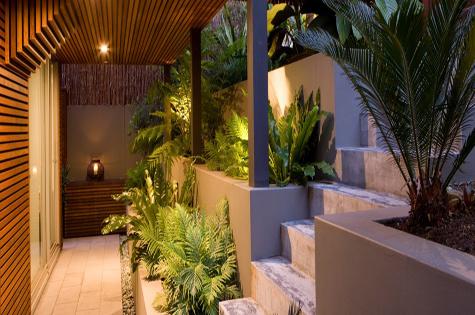Now that we're in the middle of Spring and heading into Summer, it's time to make your outdoor space an area of tranquility - a spot to be drawn to on those lazy weekend afternoons and evenings. The first thing I should make clear is that I'm no feng shui expert, but I do know what makes a garden look and feel good from a design perspective, so here are my three tips for getting on the right path to a calming garden escape.
1. Pick the Plants
For plants that thrive in the warmer months, look to a mainly green palette with thick foliage plants and oversized leafs with pops of accent colour.
Calocasia will provide your garden with bold foliage, while the Abyssinian Banana Palm will give your landscape the dark green palette with a touch of claret for variety. Adding to those textures and hues, think of incorporating Phormium or Cordylines, available in a variety of shapes and colours they are perfect inclusion to suit your style, scheme and climate. Or a European fan palm gives a lush backdrop. A spot of silver or grey never goes astray, try helichrysum or teucrium.
2. Set the path
Ensuring a garden path creates a journey to the front of the garden or house, rather than a direct line is another design practice I recommend. I has positive feng shui, and it looks interesting.
Start by thinking about your garden’s best assets. Create a focal point which can be emphasised by defining the way people move around and within the space.
For something that is unobtrusive and will blend well with natural tones, try hardwood timber decking or a natural stone, like limestone. Use feature/ accent lighting within the garden to highlight your chosen plants and the pathway and set the mood.
3. Let it flow - water features
Water is always a good calming element to include. As the weather heats up, cool your garden space with the calming sound of running water in small or large scale water features, incorporate a water feature (waterfalls, fountains etc.) as part of your pool and surrounds.
From pre-existing materials such as interesting urns or basins, there are a range of options to create a low maintenance, inexpensive garden pool.
4. Integrate fences
Integrating fences so they don’t cut the garden landscape off and create hard barriers is another principle I follow. If a wall or fence is seen it should be because it is part of the design to guide the eye and offset other features.
This includes the front boundary fence. In my opinion this should be broken up with planting or built with more earthy materials that soften and complement the house.
With this in mind, look to boundary/ screening plants such as Strelitzia Nicolai and Slender weaving bamboo to give that touch of privacy, or transform that dreaded old fence and enhance the atmosphere.
Aim to create natural, flowing shapes that compliment your space and structure. Instead of creating rigid, linear sections plan to encourage movement around the given area.








 Agree (0)
Agree (0) Disagree (
Disagree (











__small.png)










